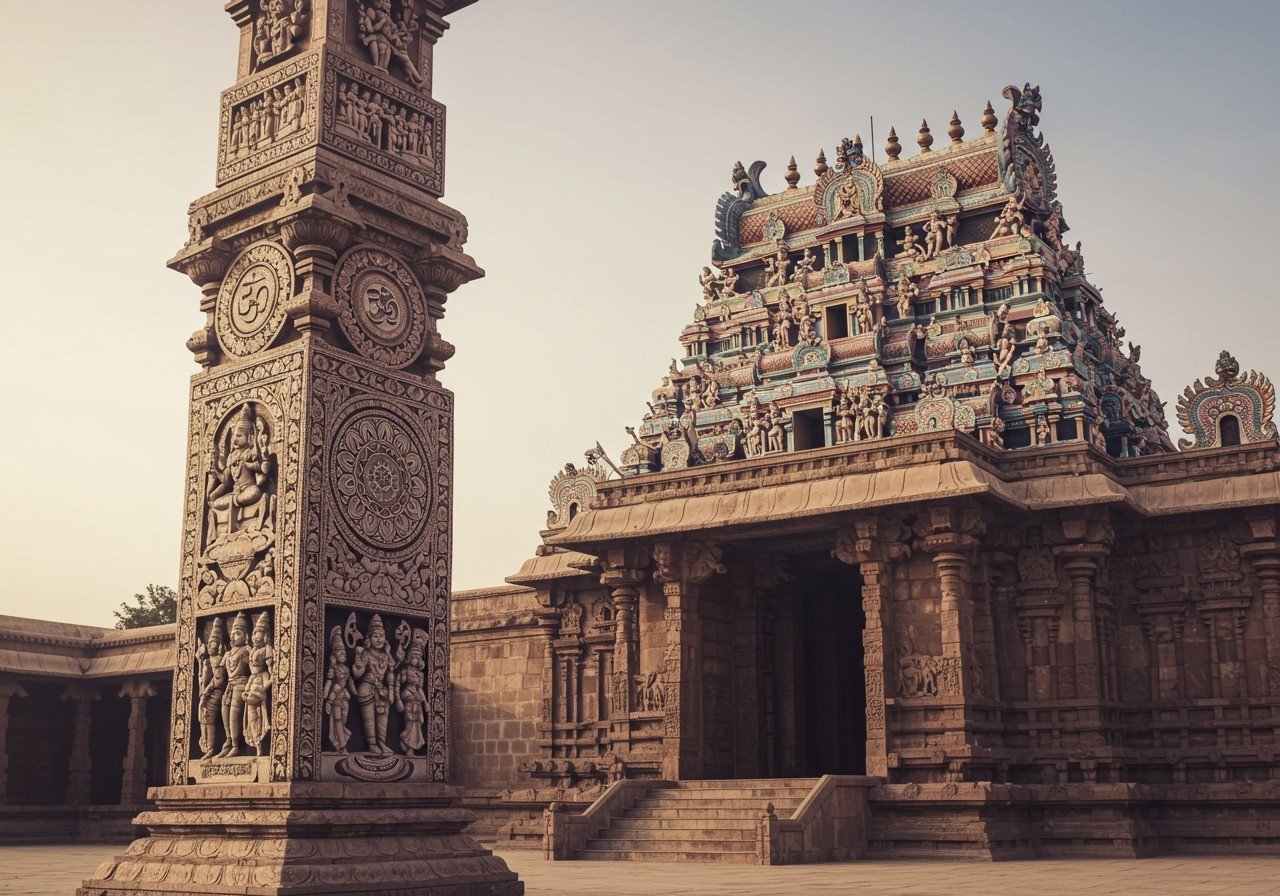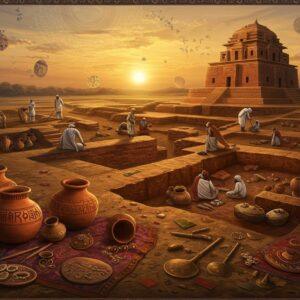Dwajasthambam: The Sacred Pillar of Divine Connection

In the heart of every traditional Hindu temple, a towering structure stands tall, reaching towards the heavens – the Dwajasthambam. More than just a flagpole, it’s a powerful symbol of faith, a conduit between the earthly and the divine. Let’s explore the profound significance of this sacred pillar and its role in our rich cultural heritage.
What is a Dwajasthambam? Often referred to as the Kodimaram or temple flagpole, the Dwajasthambam is typically located between the Gopuram (temple tower) and the Maha Mandapa (main hall). It’s not alone; you’ll usually find it accompanied by the Balipeetam (sacrificial altar) and a representation of the temple deity’s Vahana (vehicle). This sacred ensemble creates a powerful spiritual ambiance.
A Bridge Between Worlds: The Dwajasthambam is more than a physical structure; it’s a spiritual connector, a bridge between the heavens and the earth. It symbolizes the connection between humans and the divine, elevating our consciousness and deepening our understanding of the sacred. The very word ‘dhvaja’ in Sanskrit means “whatever is raised,” signifying the upward journey of the soul towards enlightenment.
Symbolism and Significance
The Dwajasthambam is rich in symbolism, representing various facets of our faith:
-
Sovereignty of God: It represents the supreme authority and presence of the divine, reminding us of the guiding force that governs the universe. It stands as a testament to the power and glory of God.
-
Righteousness and Propriety: The Dwajasthambam symbolizes dharma, righteousness, and the values that uphold our society. It serves as a constant reminder to live a life of integrity and moral conduct.
-
The Trimurti: In some temples, the Dwajasthambam represents the holy trinity of Brahma, Vishnu, and Shiva – the creator, preserver, and destroyer, respectively. It embodies the cyclical nature of life and the balance of the cosmos.
-
Hope and Conquest Over Ignorance: The flag hoisted upon the Dwajasthambam is a symbol of hope, aspiration, and the desire to overcome ignorance and attain spiritual wisdom. It represents our continuous striving for enlightenment. It’s a beacon of light guiding us towards knowledge and truth.
Dwajasthambam in Temple Festivals (Utsavas)
The Dwajasthambam plays a vital role in temple festivals or Utsavas. In fact, temples without a Dwajasthambam often refrain from holding grand celebrations. The Dwajarohanam ceremony, the hoisting of the flag, marks the commencement of these sacred festivities. It is an invitation to the gods to join in the celebration.
The Sacred Flag: The flag itself is deeply symbolic, often displaying the deity’s Vahana (vehicle). For instance, you’ll see Nandi for Shiva temples, Mayura (peacock) for Murugan temples, Mooshika (mouse) for Ganesha temples, and Garuda for Vishnu temples. These symbols, alongside other sacred emblems like the sun, moon, trident, and shankh, imbue the flag with spiritual power and significance.
Looking for authentic puja items for your home or temple? Poojn.in offers a wide selection of high-quality puja kits to enhance your spiritual practices. Browse our collection of exquisitely crafted holy idols to bring blessings into your home.
Reverence and Rituals
Devotees hold the Dwajasthambam in deep reverence. It’s believed to carry the divine energy of the deity. Many offer prayers at the base of the Dwajasthambam before entering the main sanctum, seeking blessings and purification.
-
Prayers and Prostrations: Offering prayers and prostrating before the Dwajasthambam is a common practice, demonstrating respect and humility before the divine.
-
Aakasa Deepam: During the Karthika month, the Dwajasthambam serves as a platform for raising the Aakasa Deepam (sky lamp), illuminating the temple and symbolizing the light of knowledge and spirituality.
-
Identifying the Deity: The adornments and symbols on the Dwajasthambam can often give devotees a clue about the deity residing within the temple, adding another layer of meaning to its presence. It allows devotees to understand the presiding deity and prepare their hearts for worship.
Poojn.in: Your Partner in Preserving Tradition
At Poojn.in, we understand the deep significance of the Dwajasthambam and its importance in our cultural and spiritual lives. We offer a wide range of authentic holy utensils, high-quality jaribooti, and other ritual items to help you honor this sacred symbol. Explore our collection of holy jewellery to enhance your spiritual practice.
Conclusion: A Timeless Symbol of Devotion
The Dwajasthambam is more than a mere architectural element; it’s a living symbol of our faith, connecting us to the divine and reminding us of the rich traditions that have shaped our spiritual journey. It stands as a testament to our devotion and the enduring power of our cultural heritage. As we continue to honor and cherish the Dwajasthambam, we keep the flame of devotion burning brightly within our hearts.


